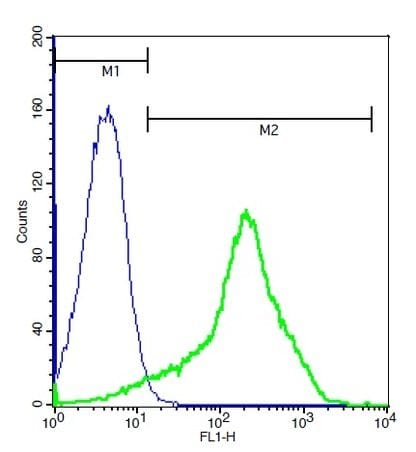Anti-FPRL1/RFP antibody (ab203129)
Key features and details
- Rabbit polyclonal to FPRL1/RFP
- Suitable for: IHC-P, Flow Cyt
- Reacts with: Mouse, Rat, Human
- Isotype: IgG
Overview
-
Product name
Anti-FPRL1/RFP antibody
See all FPRL1/RFP primary antibodies -
Description
Rabbit polyclonal to FPRL1/RFP -
Host species
Rabbit -
Tested applications
Suitable for: IHC-P, Flow Cytmore details -
Species reactivity
Reacts with: Mouse, Rat, Human -
Immunogen
Synthetic peptide within Human FPRL1/RFP aa 50-150 conjugated to keyhole limpet haemocyanin. The exact immunogen sequence used to generate this antibody is proprietary information. If additional detail on the immunogen is needed to determine the suitability of the antibody for your needs, please contact our Scientific Support team to discuss your requirements.
Database link: P25090 -
General notes
This product was previously labelled as FPRL1
Properties
-
Form
Liquid -
Storage instructions
Shipped at 4°C. Store at +4°C short term (1-2 weeks). Upon delivery aliquot. Store at -20°C long term. Avoid freeze / thaw cycle. -
Storage buffer
pH: 7.2
Preservative: 0.09% Sodium azide
Constituents: 0.01% BSA, 50% Glycerol (glycerin, glycerine)
Aqueous buffered solution. -
 Concentration information loading...
Concentration information loading... -
Purity
Protein A purified -
Clonality
Polyclonal -
Isotype
IgG -
Research areas
Images
-
 Immunohistochemistry (Formalin/PFA-fixed paraffin-embedded sections) - Anti-FPRL1/RFP antibody (ab203129)
Immunohistochemistry (Formalin/PFA-fixed paraffin-embedded sections) - Anti-FPRL1/RFP antibody (ab203129)Immunohistochemical analysis of formalin-fixed, paraffin-embedded injured rat spinal cord tissue labeling FPRL1/RFP with ab203129 at 1/200 dilution overnight at 4°C, followed by Goat Anti-Rabbit IgG, Alexa Fluor 647 conjugated secondary antibody at 1/200 dilution for 40 minutes at 37°C.
-
 Immunohistochemistry (Formalin/PFA-fixed paraffin-embedded sections) - Anti-FPRL1/RFP antibody (ab203129)
Immunohistochemistry (Formalin/PFA-fixed paraffin-embedded sections) - Anti-FPRL1/RFP antibody (ab203129)Immunohistochemical analysis of formalin-fixed, paraffin-embedded Human pneumonitis tissue labeling FPRL1/RFP with ab203129 at 1/200 dilution, followed by conjugation to the secondary antibody and DAB staining.
-
Flow cytometric analysis of Mouse splenocytes labeling FPRL1/RFP with ab203129 at 1/50 dilution, followed by incubation with Goat Anti-Rabbit IgG FITC conjugated secondary at 1/100 dilution (green) compared to control cells (blue).















